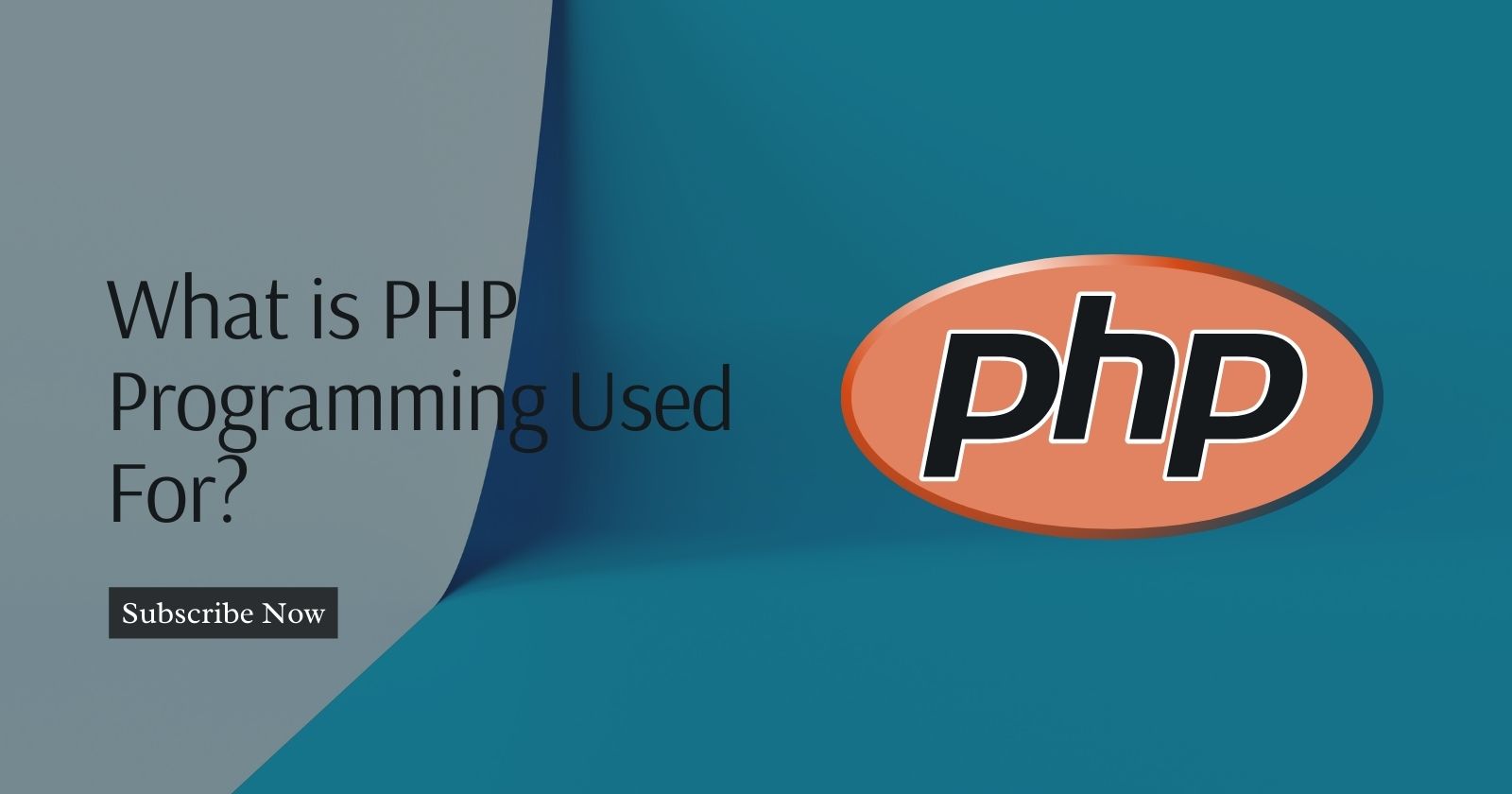What is PHP Programming Used For?
 Fanny Nyayic
Fanny Nyayic
PHP is a popular programming language that has been around since 1994. It was originally created for web development, but it has evolved to be used for a variety of purposes. In this article, we will explore the different uses of PHP programming and how it can benefit your projects.
1. Web Development
PHP's primary domain lies in web development, powering websites, and web applications. Its ability to generate dynamic content, interact with databases, and manage sessions makes it ideal for:
Content Management Systems (CMS): WordPress, Joomla, and Drupal are built predominantly using PHP. WordPress, for instance, uses PHP to handle content, themes, and plugins.
E-commerce Platforms: Platforms like Magento and WooCommerce leverage PHP for creating online stores, managing inventory, and handling transactions.
This allows for dynamic and interactive web pages, making it a popular choice for creating websites and web applications. PHP is also compatible with most web servers and operating systems, making it a versatile option for developers.
2. Server-Side Scripting:
PHP is excellent for server-side scripting, allowing developers to execute code on the server before sending the HTML to the client's browser. Common applications include:
Form Handling: Processing form data like user logins, registrations, and feedback forms. For instance, validating user input in a registration form:
if ($_SERVER["REQUEST_METHOD"] == "POST") { $username = $_POST['username']; $password = $_POST['password']; // Perform validation and database operations }Session Management: Creating and managing user sessions to maintain state across multiple pages or visits.
session_start(); $_SESSION['user_id'] = $user_id; // Access session variables on subsequent pages
3. Command-Line Scripting:
Beyond web development, PHP finds utility in command-line scripting, automating tasks, and performing system-level operations. For instance:
Task Automation: Running scheduled tasks, batch processing, or handling system administration tasks.
// Script to resize all images in a folder $images = glob("images/*.jpg"); foreach ($images as $image) { // Perform resizing operations }
4. APIs and Web Services:
PHP facilitates the creation and consumption of APIs and web services, allowing communication between different software systems. For example:
RESTful APIs: Developing APIs for mobile apps or external services to access and manipulate data from a server.
// Creating a basic RESTful API endpoint if ($_SERVER['REQUEST_METHOD'] === 'GET') { $data = ['message' => 'Hello, World!']; echo json_encode($data); }
5. Prototyping and Rapid Development:
Its simplicity and a vast array of built-in functions make PHP ideal for rapid prototyping and quick web development iterations.
- Prototype Development: Creating quick proof-of-concept applications or testing new ideas due to its rapid development capabilities.
6. Plugin Development
1. WordPress:
Plugin Structure:
Hooks and Filters: WordPress utilizes PHP to create plugins by using hooks and filters. Hooks allow developers to "hook into" specific points in the WordPress lifecycle to execute custom code.
// Adding a custom function to a WordPress hook add_action('init', 'custom_function'); function custom_function() { // Your custom code here }Custom Post Types and Taxonomies: PHP facilitates the creation of custom post types, taxonomies, and meta boxes within WordPress plugins.
// Creating a custom post type function create_custom_post_type() { register_post_type('custom_type', $args); } add_action('init', 'create_custom_post_type');Admin Panel Integration: PHP allows developers to add options and settings pages in the WordPress admin panel for plugin configurations.
// Adding settings page function plugin_settings_page() { add_options_page('Plugin Settings', 'Plugin Settings', 'manage_options', 'plugin-settings', 'plugin_settings_page_content'); } add_action('admin_menu', 'plugin_settings_page');
2. Joomla:
Extension Development:
MVC Architecture: Joomla extensions, including plugins, modules, and components, are built using PHP following the Model-View-Controller (MVC) architecture.
// Creating a Joomla plugin class plgContentCustom extends JPlugin { public function onContentPrepare($context, &$article, &$params, $page = 0) { // Your custom code here } }Event Handlers: PHP is used to define event handlers that respond to specific triggers or events in Joomla's execution flow.
// Event handler in Joomla plugin function onAfterRender() { // Your custom code here }Database Interactions: PHP facilitates database interactions for Joomla plugins, allowing developers to store and retrieve data efficiently.
// Database query in Joomla plugin $db = JFactory::getDbo(); $query = $db->getQuery(true); $query->select($db->quoteName('id', 'name'));
3. Drupal:
Module Development:
Hooks and Callbacks: PHP in Drupal allows developers to define hooks and callbacks to extend the system's functionality.
// Implementation of hook_menu in Drupal module function mymodule_menu() { $items['mymodule/path'] = array( 'title' => 'My Page', 'page callback' => 'mymodule_page', 'access callback' => TRUE, ); return $items; }Form Building: PHP is used to create forms within Drupal modules, enabling user interaction and data submission.
// Creating a form in Drupal module function mymodule_form($form, &$form_state) { // Form elements creation return $form; }
PHP's integral role in building plugins for CMS platforms showcases its versatility in extending functionalities, modifying behavior, and enhancing the user experience within these systems.
7. Meta Programming
PHP also has the ability to write and manipulate its own code, known as meta programming. This allows developers to create more efficient and dynamic code, as well as automate certain tasks.
For example, a developer can use meta programming to generate code for repetitive tasks, saving time and effort. This feature is especially useful for large and complex projects.
8. Artificial Intelligence
While PHP is not typically associated with artificial intelligence (AI), it is possible to use it for AI programming. There are libraries and frameworks available that allow developers to incorporate AI into their PHP projects.
This can be useful for creating chatbots, recommendation engines, and other AI-powered features on websites and web applications.
1. Natural Language Processing (NLP):
Chatbots and Conversational Interfaces:
Using PHP for Backend Logic: PHP can serve as the backend logic to handle user interactions and integrate with AI-powered chatbot frameworks like Dialogflow or Wit.ai.
// PHP handling chatbot requests $user_message = $_POST['message']; // Use an API to interact with the AI chatbotIntegrating with NLP APIs: PHP facilitates communication with NLP APIs for tasks like sentiment analysis, entity recognition, or language translation.
// Communicating with an NLP API $text = "This is a sample text for sentiment analysis."; $api_endpoint = "https://api.nlp-service.com/sentiment"; // Make an API call using PHP cURL or libraries like Guzzle
2. Machine Learning (ML):
Predictive Analysis and Recommendation Systems:
Data Processing with PHP: PHP can preprocess and clean data before feeding it into machine learning models.
// Data preprocessing with PHP $raw_data = fetchDataFromDatabase(); // Clean and format data for ML model trainingCalling ML Models: PHP can act as an intermediary between the user interface and machine learning models, handling input/output and displaying predictions or recommendations.
// Invoking a machine learning model $input_data = prepareDataForModel($user_input); $prediction = makePredictionWithModel($input_data);
3. Image Recognition:
Integrating AI-powered Image Processing:
PHP for Image Upload and Processing: PHP can manage image uploads and interact with AI services for tasks like object detection or image classification.
// Uploading and processing images with PHP $uploaded_image = $_FILES['image']['tmp_name']; // Use an AI service to analyze the imageDisplaying AI-Enhanced Results: PHP can present AI-generated metadata or processed images to users.
// Displaying AI-generated results $detected_objects = getDetectedObjectsFromAI(); // Display results to the user
4. Personalization and Recommendation Engines:
Utilizing AI-driven Recommendations:
PHP Handling Recommendation Queries: PHP can manage user preferences and query recommendation engines to personalize content.
// PHP querying a recommendation engine $user_preferences = getUserPreferences(); // Query the recommendation engine based on preferencesDisplaying Personalized Content: PHP processes AI-generated recommendations and displays personalized content to users.
// Displaying personalized recommendations $recommended_content = getRecommendationsFromAI(); // Present personalized content to the user
Integrating AI functionalities with PHP empowers developers to create intelligent, data-driven applications that leverage AI's capabilities to enhance user experiences, provide smarter interactions, and offer personalized services.
9. Desktop Applications
PHP isn't typically used as the primary language for building desktop applications due to its nature as a server-side scripting language.
However, PHP-GTK (PHP-GTK2 specifically) is a binding for the GTK+ toolkit which allows for the creation of GUI applications in PHP.
While not as common as other languages for desktop development, PHP-GTK demonstrates how PHP can be utilized for desktop applications.
1. Desktop GUI Applications:
Example: Creating a Simple PHP-GTK Application
#!/usr/bin/php -q
<?php
if (!class_exists('Gtk')) {
die("PHP-GTK2 is not installed\n");
}
$window = new GtkWindow();
$window->set_title("PHP-GTK Example");
$window->connect_simple('destroy', array('Gtk', 'main_quit'));
$button = new GtkButton('Click Me');
$button->connect_simple('clicked', function() {
echo "Button Clicked!\n";
});
$window->add($button);
$window->show_all();
Gtk::main();
?>
2. Administrative Tools:
PHP can be used to create desktop tools for administrative purposes such as system monitoring, database management, or log analysis. These tools might interact with the server remotely using PHP to retrieve and display information.
3. Data Processing Tools:
Developers can build desktop applications in PHP to handle data processing tasks like file manipulation, CSV parsing, or data conversions.
4. Internal Business Tools:
PHP can create desktop applications for internal business processes like inventory management, employee time tracking, or document management.
5. Hybrid Applications:
Combining PHP with other technologies, like Electron, developers can create hybrid desktop applications. While the core of Electron applications is built using web technologies (HTML, CSS, JavaScript), PHP could be used to handle server-side functionalities or interact with databases.
Example:
An Electron app using PHP for server-side operations:
// main.js (Electron)
const { app, BrowserWindow } = require('electron');
function createWindow() {
const win = new BrowserWindow({
width: 800,
height: 600,
webPreferences: {
nodeIntegration: true
}
});
win.loadFile('index.html');
}
app.whenReady().then(createWindow);
<!-- index.html -->
<!DOCTYPE html>
<html>
<head>
<title>Electron PHP App</title>
</head>
<body>
<h1>Hello Electron with PHP!</h1>
</body>
</html>
Using PHP within desktop applications is less common due to PHP's origin and focus on web development.
Conclusion
PHP programming has a wide range of uses and can benefit a variety of projects. From web development to AI programming, PHP offers a versatile and powerful platform for developers.
Its ease of use and compatibility with different systems make it a popular choice for creating dynamic and interactive websites and applications. Whether you are a beginner or an experienced developer, PHP is a valuable tool to have in your programming arsenal.
Have you used PHP for any of these purposes? Are there any other uses of PHP that you have found useful?
Let us know in the comments.
Subscribe to my newsletter
Read articles from Fanny Nyayic directly inside your inbox. Subscribe to the newsletter, and don't miss out.
Written by

Fanny Nyayic
Fanny Nyayic
a passionate web developer, tech writer, open-source contributor & a life long learner.